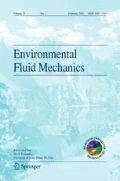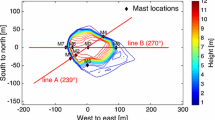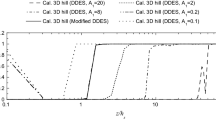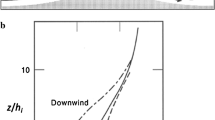Abstract
The advanced research version of the weather research and forecasting model was employed to simulate Intense Operational Periods of the field campaigns of the Mountain Terrain Atmospheric Modeling and Observations (MATERHORN) Program with a 0.5 km horizontal resolution. The focus was on synoptically dominated stably stratified periods, with the mean flow approaching a strongly non-symmetrical rugged topography—the Granite Mountain of the US Army Dugway Proving Ground, Utah. The model was validated against a comprehensive set of MATERHORN data. The special in-house developed software enabled calculations of energetics and pressure anomalies along individual streamlines and tracing of spatial trajectories of streamlines. Owing to complexities of natural flows, for example, the directional shear (skewed vertical velocity profiles) and irregular topographic shape, the flow patterns depend on multiple parameters, although in idealized cases the flow is described by a single parameter (Froude number or a variant). Streamlines at different altitudes of a given location diverged rapidly, making it difficult to study the dividing streamline concept. The new software allowed identification of the dividing streamline passing over the highest crest (summit) of the mountains and its trajectory. The upstream height of the dividing streamline did not follow the well-known Sheppard’s formula. Three cases of flow patterns are presented, identified based on the presence of lee waves, flow separation, horizontal vortex shedding and hydraulics jumps.














Similar content being viewed by others
References
Baines PG (1979) Observations of stratified flow past three-dimensional barriers. J Geophys Res Ocean 84(C12):7834–7838
Baines PG (1995) Topographic effects in stratified flows. Cambridge University Press, Cambridge
Brighton PWM (1978) Strongly stratified flow past three-dimensional obstacles. Q J R Meteorol Soc 104:289–307
Chen F, Dudhia J (2001) Coupling an advanced land surface-hydrology model with the Penn State-NCAR MM5 modelling system. Part I: model implementation and sensitivity. Mon Weather Rev 129:569–585
Dimitrova R, Silver Z, Zsedrovits T, Hocut CM, Leo LS, Di Sabatino S, Fernando HJS (2015) Assessment of planetary boundary-layer schemes in the weather research and forecasting mesoscale model using MATERHORN field data. Bound Layer Meteorol 159(3):589–609
Ding L, Calhoun RJ, Street RL (2003) Numerical simulation of strongly stratified flow over a three-dimensional hill. Bound Layer Meteorol 107(1):81–114
Doyle J, Durran D (2002) The dynamics of mountain-wave-induced rotors. J Atmos Sci 59:186–200
Dudhia J (1989) Numerical study of convection observed during the winter monsoon experiment using a mesoscale two-dimensional model. J Atmos Sci 46:3077–3107
Fernando HJS, Pardyjak ER, Di Sabatino S, Chow FK, De Wekker SFJ, Hoch SW, Hacker J, Pace JC, Pratt T, Pu Z, Steenburgh WJ, Whiteman CD, Wang Y, Zajic D, Balsley B, Dimitrova R, Emmitt GD, Higgins CW, Hunt JCR, Knievel JC, Lawrence D, Liu Y, Nadeau DF, Kit E, Blomquist BW, Conry P, Coppersmith RS, Creegan E, Felton M, Grachev A, Gunawardena N, Hang C, Hocut CM, Huynh G, Jeglum ME, Jensen D, Kulandaivelu V, Lehner M, Leo LS, Liberzon D, Massey JD, Mc Enerney K, Pal S, Price T, Sghiatti M, Silver Z, Thompson M, Zhang H, Zsedrovits T (2015) The MATERHORN: unraveling the intricacies of mountain weather. Bull Am Meteorol Soc 96:1945–1967. https://doi.org/10.1175/BAMS-D-13-00131.1
Fry J, Xian G, Jin S, Dewitz J, Homer C, Yang L, Barnes C, Herold N, Wickham J (2011) Completion of the 2006 national land cover database for the conterminous United States. PE&RS 77:858–864
Gesch D, Oimoen M, Greenlee S, Nelson C, Steuck M, Tyler D (2002) The national elevation dataset. Photogramm Eng Remote Sens 68(1):5–32
Grachev A, Leo LS, Di Sabatino S, Fernando HJS, Pardyjak E, Fairall CW (2015) Structure of turbulence in katabatic flows below and above the wind-speed maximum. Bound Layer Meteorol. https://doi.org/10.1007/s10546-015-0034-8
Greenslade MD (1995) Strongly stratified airflow over and around mountains in stably stratified flows: flow and dispersion over topography. In: Castro, Rockliff (eds) Proceedings of the IV conference on stably stratified flows, September, 1992. Clarendon Press, Oxford
Grubisic V, Lewis JM (2004) Sierra Wave Project revisited: 50 years later. Bull Am Meteorol Soc 85:1127–1142
Hertenstein RF, Kuettner JP (2005) Rotor types associated with steep lee topography: influence of the wind profile. Tellus 57:117–135
Hertenstein RF (2009) The influence of inversions on rotors. Mon Weath Rev 137:433–446
Holmboe J, Klieforth H (1957) Investigation of mountain lee waves and the airflow over the Sierra Nevada. Contract AF19(604)-728, Department of Meteorology, University of California, Los Angeles, 290 pp
Hunt JCR, Feng Y, Linden PF, Greenslade MD, Mobbs SD (1997) Low-Froude-number stable flows past mountains. Soc Ital Fis 20C(3):261–272
Hunt JCR, Olafsson H, Bougeault P (2001) Coriolis effects on orographic and mesoscale flows (Paper presented at Am Met. Sci. Jan 1998). Q J R Meteorol Soc 127(572):601–633
Hunt JCR, Snyder WH (1980) Experiments on stably and neutrally stratified flow over a model three-dimensional hill. J Fluid Mech 96(4):671–704
Hunt JCR, Vilenski GG, Johnson ER (2006) Stratified separated flow around a mountain with an inversion layer below the mountain top. J Fluid Mech 556:105–119
Legates DR, McCabe GJ Jr (1999) Evaluating the use of “goodness-of-fit” measures in hydrologic and hydroclimatic model validation. Water Resour Res 35(1):233–241
LeMone MA, Tewari M, Chen F, Dudhia J (2014) Objectively determined fair-weather NBL features in ARW-WRF and their comparison to CASES-97 observations. Mon Weather Rev 142(8):2709–2732
Leo LS, Thompson MY, Di Sabatino S, Fernando HJS (2015) Stratified flow past a hill: dividing streamline concept revisited. Bound Layer Meteorol 159(3):611–634
Lester PF, Fingerhut WA (1974) Lower turbulent zones associated with lee waves. J Appl Meteorol 13:54–61
Li D, Calhoun RJ, Street RL (2002) Numerical simulation of strongly stratified flow over a three-dimensional hill. Bound Layer Meteorol 107:81–114
Lin Q, Lindberg WR, Boyer DL, Fernando HJS (1992) Stratified flow past a sphere. J Fluid Mech 240:315–354
Lin YL, Farley RD, Orville HD (1983) Bulk parametrization of the snow field in a cloud model. J Appl Meteorol 22:1065–1092
Lindeman J, Broutman D, Eckermann SD, Ma J, Rottman J, Boybeyi Z (2012) Mesoscale model initialization of the Fourier method for mountain waves. J Atmos Sci 65:2749–2756
Massey J, Steenburgh WJ, Hoch SW, Knievel JC (2014) Sensitivity of near-surface temperature forecasts to soil properties over a sparsely vegetated dryland region. J Appl Meteorol Clim 53(8):1976–1995
Mlawer EJ, Taubman SJ, Brown PD, Iacono MJ, Clough SA (1997) Radiative transfer for inhomogeneous atmospheres: RRTM, a validated correlated-k model for the longwave. J Geophys Res Atmos 102(14):16663–16682
National Geophysical Data Center/NESDIS/NOAA/U.S (2018) Department of Commerce, 2001: ETOPO2, Global 2 Arc-minute Ocean Depth and Land Elevation from the US National Geophysical Data Center (NGDC). Research Data Archive at the National Center for Atmospheric Research, Computational and Information Systems Laboratory, Boulder, CO. https://doi.org/10.5065/D6668B75. Accessed 05 Feb 2018
Pan H-L, Wu W-S (1995) Implementing a mass flux convective parameterization package for the NMC medium-range forecast model. NMC Office Note, No. 409
Reinecke PA, Durran DR (2008) Estimating topographic blocking using a Froude number when the static stability is nonuniform. J Atmos Sci 65(3):1035–1048
Rife DL, Warner TT, Chen F, Astling EG (2002) Mechanisms for diurnal boundary layer circulations in the Great Basin Desert. Mon Weather Rev 130:921–938
Sha W, Nakabayashi K, Ueda H (1998) Numerical study on flow pass of a three-dimensional obstacle under a strong stratification condition. J Appl Meteorol 37:1047–1054
Sheppard PA (1956) Airflow over mountains. Q J R Meteorol Soc 82:528–529
Smith RB (1989) Comment on “Low Froude number flow past three-dimensional obstacles. Part I: baroclinically generated lee vortices”. J Atmos Sci 46(23):3611–3613
Smith RB (1989) Mountain-induced stagnation points in hydrostatic flow. Tellus A 41(3):270–274
Snyder WH, Thompson RS, Eskridge RE, Lawson RE, Castro IP, Lee JT, Hunt JCR, Ogawa Y (1985) The structure of strongly stratified flow over hills: dividing-streamline concept. J Fluid Mech 152:249–288
Stull RB (1988) An introduction to boundary layer meteorology. Kluwer Academic Publishers, Dordrecht, p 603
Sukoriansky S, Galperin B, Perov V (2005) Application of a new spectral theory of stably stratified turbulence to the atmospheric boundary layer over sea ice. Bound Layer Meteorol 117(2):231–257
Vosper SB, Castro IP, Snyder WH, Mobbs SD (1999) Experimental studies of strongly stratified flow past three-dimensional orography. J Fluid Mech 390:223–249
Vosper SB, Sheridan PF, Brown AR (2006) Flow separation and rotor formations beneath two-dimensional trapped lee waves. Q J R Meteorol Soc 132:2415–2438
Willmott CJ (1981) On the validation of models. Phys Geogr 2:184–194
Acknowledgements
This research was funded by the US Office of Naval Research Award # N00014-11-1-0709, Mountain Terrain Atmospheric Modelling and Observations (MATERHORN) Program. During the latter part of the work, the work was supported by NSF Grant AGS-1565535. It has also been supported by the European Union and the State of Hungary in the framework of TÁMOP-4.2.1.B-11/2/KMR-2011-0002 Instrument. Additional support was provided by the University of Notre Dame’s Centre for Research Computing through computational and storage resources (we specifically acknowledge the assistance of Dodi Heryadi). We are thankful to Jeffrey Massey from the University of Utah for the updated land cover and soil data. Furthermore, we would like to thank Aaron S. Donahue for creative inspiration in the computations of this work.
Author information
Authors and Affiliations
Corresponding author
Additional information
Publisher’s Note
Springer Nature remains neutral with regard to jurisdictional claims in published maps and institutional affiliations.
Appendix: A new computational tool for visualization and analysis
Appendix: A new computational tool for visualization and analysis
A new numerical and visualization tool was developed that enabled tracing of 3D stream surfaces, or a single 3D streamline throughout the model domain. The program is written in the Matlab environment. It is capable of interpolating not only the path of a streamline through the model domain in 3D, but also computes any of the 3D WRF variables along the streamline that includes, but is not limited to kinetic and potential energies, Brunt-Väisälä Frequency, pressure perturbations, and buoyancy frequency. These values were computed at every given point along a streamline. The mixing ratio, pressure, and potential temperature are all interpolated along the line that is tangent to the 3D velocity vector field.
The software was first tested against an analytical streamline solution in 3D, and furthermore, a step size refinement was tested within the model domain. The position (in x, y, z), which is contained within the domain should be selected to initiate the sequence of finding the points along a streamline. This position can be used in one of the three ways. First, it may be used to start a streamline, and the streamline will continue until it reaches a boundary of the domain or a maximum horizontal distance within the domain at which distance the streamline will be terminated. Second, the point can be selected as the ending point, and the distance that the streamline should begin upstream may be specified. The third option allows extracting a vertical slice along a specified angle (from the north) along with the horizontal extent of the line
To test the software, we used 133 time periods that were driven by large-scale flow during the early morning hours. The origin point of these streamlines was refined to locate the exact height that would produce a line that reached the mountaintop (summit) of the mountain. Since the analysis incorporated streamlines that originated from many different locations in the simulation domain, depending on the flow direction for a particular time period, the streamlines were grouped based on the wind direction from which the dividing streamline approached the obstacle. Each direction group must be considered separately. Ultimately this tool allowed for the Sheppard criterion to be evaluated for realistic atmospheric conditions.
Rights and permissions
About this article
Cite this article
Silver, Z., Dimitrova, R., Zsedrovits, T. et al. Simulation of stably stratified flow in complex terrain: flow structures and dividing streamline. Environ Fluid Mech 20, 1281–1311 (2020). https://doi.org/10.1007/s10652-018-9648-y
Received:
Accepted:
Published:
Issue Date:
DOI: https://doi.org/10.1007/s10652-018-9648-y




